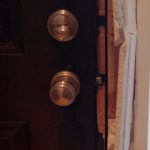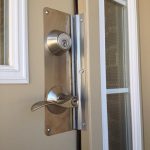5 Questions for Door Reinforcement
Wooden doors are often the target of forced entry by burglars. Forced entry on doors is usually in the form of kicking, prying, or an aggressive attack through the door on the lock itself.
Here are 5 questions to consider when reinforcing a door. This will better help you achieve your goal of reducing the occurrence of burglary attempts on your door and also reducing the likelihood of success should a burglar attempt a forced entry.
1. Do you have a Security Deadbolt?
A deadbolt is your basic door security hardware. In most cases a locking latch such as in a knob set or lever set is more vulnerable than a proper deadbolt. A deadbolt is called a “dead” bolt because it “dead” locks. It does not move freely in the fully extended locked position. Other security feature on a deadbolt prevent against various methods of destructive entry and manipulation. A thorough understanding of these methods and various vulnerabilities is important when selecting a deadbolt. An understanding of independent ratings and what they mean and what they do not mean is also important.
These deadbolts are not available at large hardware retailers where often poorly designed products are sold. It is best to have your security hardware installed by a professional experienced both in proper installation as well as methods of entry.
2. How Strong is the Frame?
A deadbolt when locked is only as strong as the cavity that it inserts into. In many cases the strike plate around the deadbolt tunnel is secured only to the jamb wood and not to the stronger structure of the frame. Strike plates with longer screws provide more resistance against forced attacks directed inward. Longer strike plates secured to the door frame spread the force out providing even more resistance.
3. How Strong is the Door?
A folded steel door is strong but vulnerable to attacks through being compressed. A solid core wooden or composite door is vulnerable to splitting. Reinforcing plates that wrap around both front and back are appropriate for wooden doors. Heavy guards that cover all lock hardware except the area around the keyway may be appropriate for steel doors.
4. Does the Door Interlock with the Frame?
A common way of gaining entry is using a pry bar or similar tool to pry the door open by force. Interlocking guards can be installed to resist and deter this attack. Full length guards can make it difficult to place the bar at all. Smaller guards can cover the area directly around the deadbolt and latch and interlock to resist the prying attempt.
5. Are the Hinges Secure?
Out swinging doors should be installed with non-removable pin hinges. Otherwise hinges can be knocked out with simple hand tools and a locked door can be pried out from the hinge side. Another option is security hinge screws.
Much consideration is needed to properly secure a door from the various forced entry attempts employed by intruders. Contact a Professional Locksmith and Security Hardware Installer to have your security needs assessed and doors secured.





